Noront Resources Ltd.
McFaulds Cu-Zn-Ag VMS Deposits

Overview
The McFaulds volcanogenic massive sulphide (VMS) deposits were the first discoveries in the ROF and spurred the initial staking rush in 2002-2003. Since then, ten Cu-Zn rich VMS lenses have been identified on the property, three of which (No. 1, No. 3 and No. 8) have calculated resources and are collectively known as the Nikka deposit. In 2015 Noront acquired an 85% interest in the McFaulds property through the acquisition of Cliffs Natural Resources’ assets in the ROF. The McFaulds property is now held jointly between Noront (85%) and KWG Resources (15%).
Early exploration on the property focused on near-surface mineralization easily detected with airborne geophysics. This exploration methodology successfully identified seven Cu-Zn mineral occurrences. However, after the discovery of Eagle’s Nest and the various chromite deposits in the ROF, exploration shifted away from VMS to magmatic Ni-Cu-PGE and chromite.
Starting in late 2016, Noront renewed its interest in the area by systematically compiling and reviewing historic geological, geochemical, and geophysical datasets, including re-logging one-quarter of all historical drill holes at McFaulds and acquiring a high-resolution airborne magnetic survey which forms the basis for our current geological model. Following up on this initial work, in 2017 Noront completed ground and borehole EM surveys and executed its first ever drill program at McFaulds which led to the discovery of a new sulphide lens, No. 8, located 175m into the footwall of the high-grade No. 3 lens. Subsequent drilling has identified an additional two VMS exhalative horizons, No. 9 and No. 10.
Noront is actively exploring the area through the integration of new data from geophysical surveys and diamond drilling with historical results and a refined deposit model.
Deposit Geology & Mineralization
The McFaulds VMS deposits are situated within in a structurally controlled volcanic basin near the top of the Muketei Assemblage, stratigraphically above the ultramafic sills hosting the Ni-Cu-PGE and chromite resources and above the large Thunderbird layered ferrogabbro body (figure 1). High resolution age-dating by the OGS and GSC has determined the age of these underlying intrusive suites and the overlying volcanic succession to be virtually the same, suggesting the heat source for hydrothermal VMS mineralization at McFaulds may have been driven by cooling of these large, high-temperature magmatic bodies.
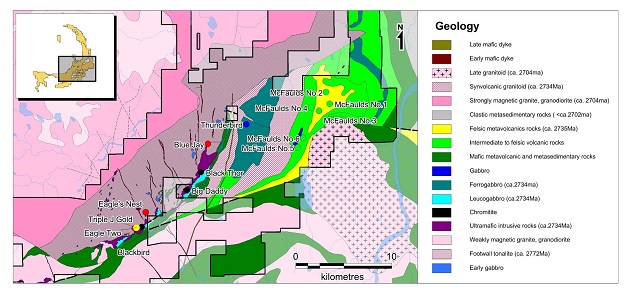
FIGURE 1: REGIONAL GEOLOGY OF THE SOUTHERN ROF
The McFaulds deposits are hosted within a northeast trending, northwest facing, folded sequence of altered felsic to intermediate tuffs and lesser flows (figure 2) deposited into an interpreted half graben based on the asymmetry of the volcanic basin. Mineralization consists dominantly of pyrite-chalcopyrite-sphalerite rich banded sulfides and stringers. Broad zones of chlorite alteration mark the exhalative horizons with intense talc-magnetite zones immediately adjacent to or within the mineralized zones at No. 1 and No. 3. The copper-rich nature of the mineralization along with the presence of talc-magnetite zones attest to the high-temperature nature of the VMS hydrothermal system at McFaulds.
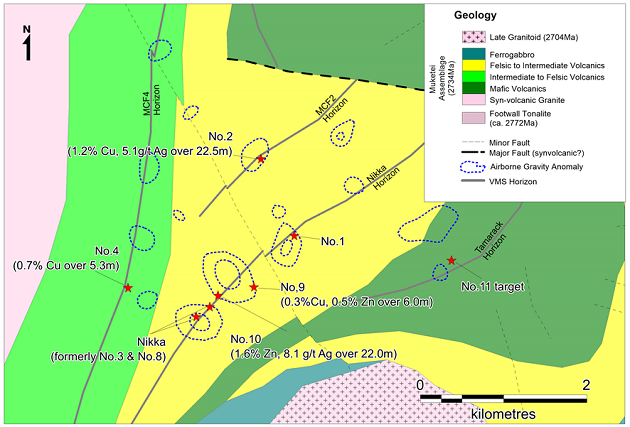
FIGURE 2: MCFAULDS PROPERTY GEOLOGY SHOWING VMS HORIZONS, KNOWN SULFIDE LENSES AND IDENTIFIED GRAVITY ANOMALIES
Vertical stacking of VMS mineralized zones over hundreds of meters as at No.8, No.10, No.3 and No.4 suggest a primary volcanic structural control to the mineralization (figure 3) as seen in other VMS camps in the Superior Province, and which provides a useful exploration vector.
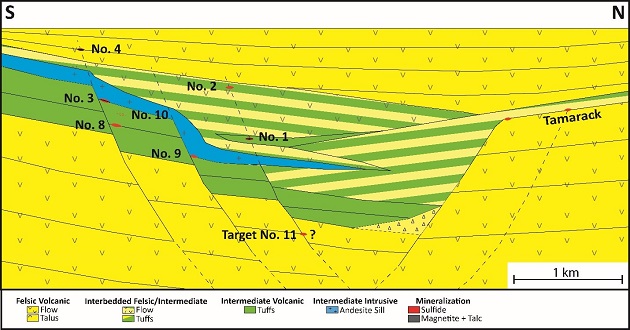
FIGURE 3: CONCEPTUAL MODEL OF THE MCFAULDS VMS BASIN
Based on the results of our recently acquired high resolution airborne magnetic survey and in conjunction with our re-logging, 3D modelling efforts, and new drilling results, we have identified four main VMS horizons on the property (figure 2). From bottom to top these are the: i) Tamarack horizon, ii) Nikka horizon (host to No. 1, No. 3, No. 8, No. 9, No. 10 and No. 6 sulfide lenses), iii) No. 2 horizon, and iv) No. 4 and No. 5 horizon.
Since initiating our VMS strategy in the fall of 2016, our understanding of the volcanic stratigraphy and mineralizing controls on the McFaulds property has improved dramatically. Current thinking is that the plunge of the No. 8 lens is largely controlled by syn-volcanic faults which were responsible for the formation of a 3rd order basin within which were deposited the host volcanic sediments and tuffs as portrayed in figure 4.
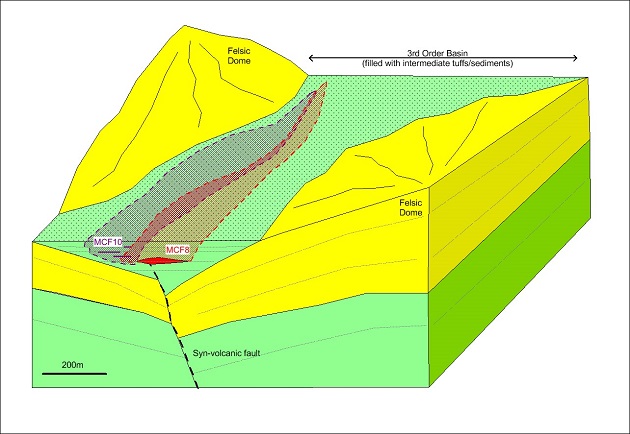
FIGURE 4: CONCEPTUAL MODEL OF THE DEPOSITIONAL ENVIRONMENT AT NO.8 AND NO.10
Project Details
The Nikka deposit (i.e. No. 1, No. 3 and No. 8 sulphide lenses) are the centerpiece of a 1,043 claim-cell property held 85% by Noront and 15% by KWG Resources. Noront continues to explore the property with the aim of defining a minimum 5-10Mt of potentially mineable copper-zinc resources to feed a central milling operation in the future.
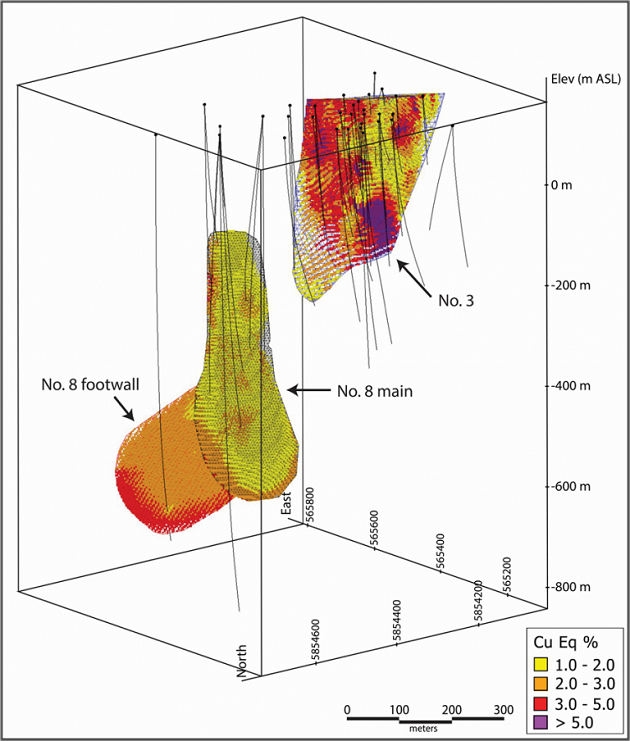
FIGURE 5: 3D VIEW OF THE NIKKA DEPOSIT BLOCK MODEL SHOWING THE NO. 3, NO. 8 MAIN AND NO. 8 FOOTWALL SULFIDE LENSES
Project Status
Noront has been actively exploring the property since 2017, completing 18 drill holes totaling 9,125m coupled with 36 borehole EM surveys, 78 line-km of ground EM and 33 line-km of ground gravity surveys, in addition to 1,941 km of high resolution airborne magnetic surveying. This work has led to the discovery of three new VMS horizons, the most significant being No.8, which returned 26.4m of massive sulfides grading 2.1% Cu, 3.4% Zn, 5.5g/t Ag and 0.2g/t Au in hole MCF-18-98.
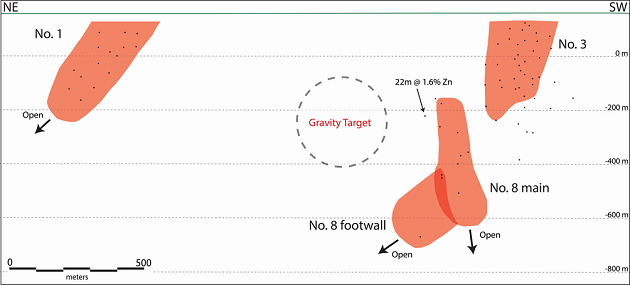
FIGURE 6: LONG-SECTION OF THE NIKKA EXHALATIVE HORIZON SHOWING THE NO. 1, NO.3 AND NO.8 SULFIDE LENSES, INTERPRETED LOCATION OF THE LARGE GRAVITY ANOMALY AND DRILL HOLE PIERCE POINTS
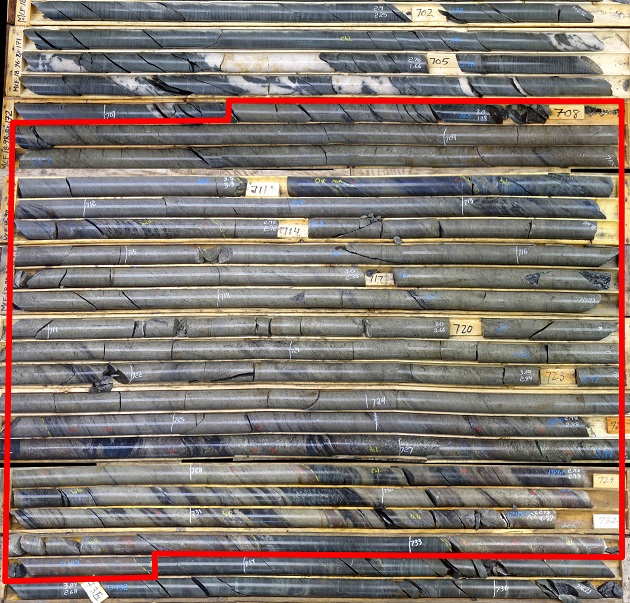
FIGURE 7: MASSIVE SULFIDE INTERSECTION IN MCF-18-98 GRADING 2.1% CU, 3.4% ZN, 5.5G/T AG AND 0.2G/T AU OVER 26.4M (ESTIMATED 20M TRUE THICKNESS)
Drilling in 2019 along strike and down dip of hole MCF-18-98 intersected copper-rich stringer sulfides in strongly altered volcanic tuffs including 20.0m grading 2.0% Cu and 4.8g/t Ag in hole MCF-19-102, and 10.1m grading 3.3% Cu and 6.5g/t Ag in MCF-19-103. Hole MCF-19-103, located 215m down-dip from MCF-18-98, represents the largest step-out drill hole to date at No.8 and attests to the robustness of the hydrothermal system.
Assay highlights of the holes drilled by Noront to date on the McFaulds property are listed in the table below.
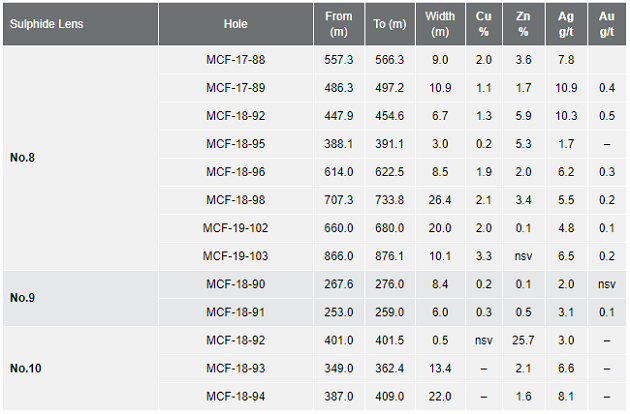
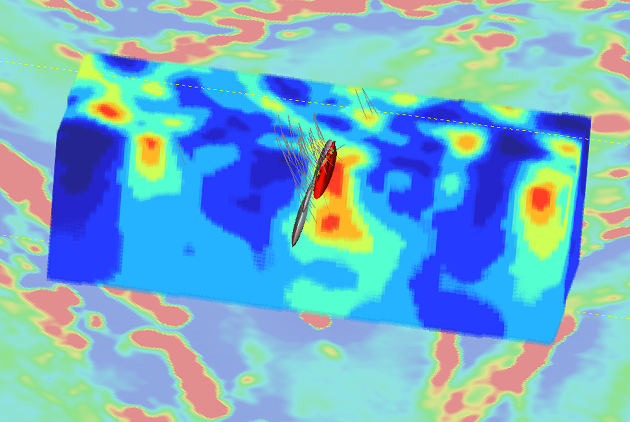
FIGURE 8: PRELIMINARY INVERSION MODEL OF THE RECENT SURFACE GRAVITY SURVEY OVER THE NO.3 AND NO. 8 LENSES SHOWING KNOWN VMS MINERALIZATION AT DEPTH AND COINCIDENT DENSITY ANOMALIES
Additional targets on the property have been identified through numerous ground and airborne geophysical surveys including a 2011 airborne gravity survey flown by the Ontario Geological Survey which identified several shallow gravity anomalies, some of which are coincident with known sulfide occurrences on the property. Several of these targets remain untested, including a broad anomaly between the No. 8 and No. 1 sulfide lenses (figures 2, 6) which is interpreted to reflect a large, deep target given the wavelength of the anomaly. Ground gravity surveying in late 2018 confirmed the presence of this anomaly along strike of Nikka where shallow drilling along the edges have returned up to 22 metres grading 1.6% Zn and 8.1g/t Ag within intensely chlorite altered volcanic tuffs. These results indicate the presence of a significant hydrothermal system, making this target a high priority for the company. Noront believes there are several more VMS discoveries waiting to be found at depth on the McFaulds property based on our updated geological model.
In May 2020 the Company announced an updated resource estimate for the Nikka deposit which is presented in the table below.

Notes:
1. The effective date of the resource estimate is May 7th, 2020
2. Reported resources are based on a US$90/t NSR cut-off using 3-year average pricing for Cu (US$2.80/lb), Zn (US$1.20/lb) and Ag (US$16.52/oz). Estimated recoveries for Cu (83%), Zn (85%), and Ag (50%) are based on comparable deposits in Canada.
3. Cu equivalency is calculated as follows: Cueq = Cu(%) + Zn(%) x 0.43 + Ag(%) x 86.28. Equivalency factors were determined based on the metal prices listed above.
4. CIM Definition Standards were followed for classification of Mineral Resources. Mineral Resources are not Mineral Reserves and do not have demonstrated economic viability
5. Resources reported are for blocks above cut-off and as such, if and when mining studies are performed, may not be recoverable
Next Steps
The Company has prepared a follow-up exploration program for the McFaulds property which includes drill testing the large gravity anomaly along strike of the Nikka deposit, step-out drilling to expand the No.8 and No.1 lenses at Nikka, and additional ground gravity surveying to better resolve interpreted deep anomalies identified in past airborne surveys.
Source: https://norontresources.com/projects/mcfaulds-deposit/
